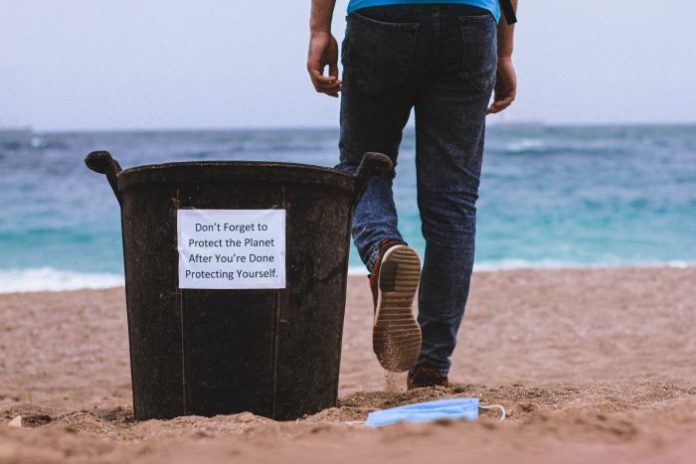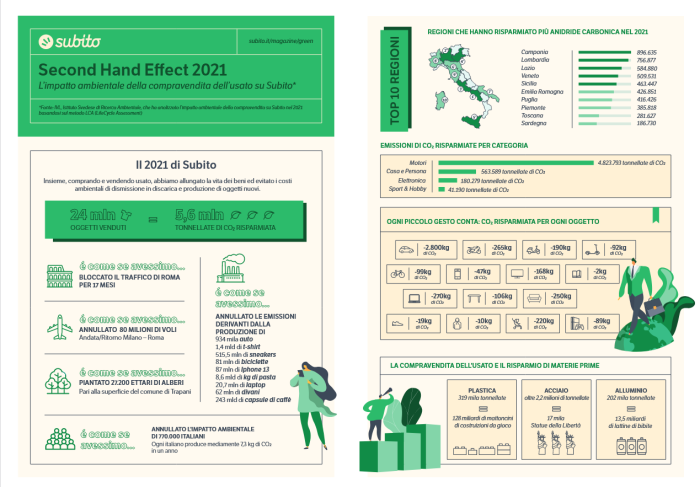
Environmental protection is a core value for Italians, who in recent years have adopted increasingly sustainable and conscious behaviour, including buying and selling second-hand goods, which is no longer a trend but a real style of consumption for 52% of Italians*, with an important economic, social and above all environmental impact.
Those who choose the second-hand economy, in fact, on the one hand give things a second life, avoiding their disposal in landfills, and on the other potentially avoid the CO2 emissions and environmental costs of producing a new good. A simple gesture within everyone’s reach, so much so that it ranks third among the green behaviours habitually implemented by Italians*, which has an immediate and measurable effect on the environment.
Once again this year Subito, Italy’s No. 1 platform for sustainable buying and selling with over 13 million unique monthly users**, thanks to the “Second Hand Effect 2021” study commissioned from IVL – Swedish Environmental Research Institute, has quantified the environmental impact, in terms of saving CO2 emissions and raw materials, of buying and selling on Subito. The method used by IVL is the Life Cycle Assessment – LCA – which takes into account the entire life cycle of the object, ‘weighing’ it in terms of CO2 emissions: from the extraction of raw materials, to their processing, to the distribution of the product, to its disposal in landfills.
In 2021, almost 24 million items were sold on Subito, resulting in a saving of 5.6 million tonnes of CO2. But what exactly do they amount to?
Saving 5.6 million tons of CO2 corresponds to zeroing the environmental footprint of almost 770,000 Italians in one year, equal to slightly less than the population of the province of Lecce (IVL estimates, in fact, that an Italian produces 7.3 tons of carbon dioxide in one year) or the amount of carbon dioxide that 27,200 hectares of forest would absorb in one year (exactly the same as the surface area of the municipality of Trapani!). Or even, to make the idea even better, it is as if traffic in Rome totally disappeared for 17 months or as if 5.5 million Rome/NY return flights were cancelled.
“Buying and selling second-hand, from a car to a smartphone or an item of clothing, not only saves money, but also and above all allows us to make a concrete and measurable contribution to the fight against climate change, one of the United Nations 2030 Sustainable Development Goals,” comments Giuseppe Pasceri, CEO of Subito. “24 million times Italians have chosen to give objects a second chance through Subito: together we have saved the planet the emission of no less than 5.6 million tonnes of CO2, as if we had planted a forest the size of the municipality of Trapani, or blocked traffic in Rome for 17 months!”
The impact of second-hand goods by category and object
The Second Hand Effect study explored the categories with the greatest positive impact in terms of CO2 savings. Motors is confirmed as the most impactful, saving 4,823,793 tonnes of CO2 in 2021. Next comes Home and Personal with 563,589 tonnes of Co2 saved. In third position is Electronics, with 180,279 tonnes of Co2 saved, and finally Sport and Hobbies, with 41,190 tonnes of Co2.
Going into detail on the objects with a more significant environmental impact, we find that, like last year, the car saves 2,800 kg of CO2, but also motorbikes save 265 kg of CO2 or, to remain in the area of mobility, the electric scooter which, bought second-hand, saves 92 kg of CO2. Widening our gaze and considering different aspects of our daily lives, we also see other, less ‘demanding’ objects that have their weight in reducing our environmental footprint: a used PC saves 270kg of CO2, a TV 168kg and a smartphone 47kg. Let’s also think about the savings from buying a used bicycle (99kg CO2) or even just a sweatshirt (10kg CO2) and, why not, a book (2kg CO2).

Saving raw materials
The second-hand economy also has an impact on raw materials, the extraction, production and use of which is avoided thanks to second-hand. In 2021, thanks to buying and selling on Subito, 2.2 million tonnes of steel were saved, equal to 27,623km of track, i.e. more than 3 times the Trans-Siberian Railway or equal to the steel used to create 17,000 Statues of Liberty!
But also 202 thousand tonnes of aluminium, which is like not having produced over 13.5 billion cans, and again 319 thousand tonnes of plastic, which is like having saved the production of 128 billion iconic construction bricks.
The ranking of the most virtuous regions
Like last year, the report analyses the most virtuous regions in saving CO2 emissions. The top positions remain unchanged: in first place we see Campania, which has saved 896,635 tonnes of CO2, followed by Lombardy with 756,877 tonnes of CO2saved, and in third place, we find Lazio, with 584,880 tonnes of CO2. Continuing in the top 5 Italian regions for CO2 savings, Veneto maintains the same positions, with a total of 509,531 tonnes of CO2 and Sicily with 463,447 tonnes of CO2 saved.
NOTE: SAMPLE AND METHODOLOGY
The research only takes into account the advertisements published on Subito by private users, while advertisements published by companies and relating to the categories services, animals and real estate were excluded. All environmental impact data relating to the ads and business management were then entered into the carbon footprint calculator created by IVL, allowing the quantification of potential positive environmental effects net of business emissions.
Life cycle analysis is a scientifically recognised research method used to calculate environmental impact, which is based on the assumption that each used product sold replaces the production of an equivalent new product and the management of product disposal. To process the environmental impact data related to the extraction and production of materials and the disposal process, IVL created a material partition based on the average composition of the items in the different categories of the platform. For example, a sofa is on average made up of: 30% wood, 11% steel, 18% polypropylene, 20% polyurethane, 10% polyester, 7% cotton, 3% leather, 1% wool. For each good, the environmental impact from the extraction of the raw material, the processing of the materials it is made of and the disposal process was calculated. Subsequently, the total was compared in kilogram carbon dioxide equivalent (CO2e). The value assigned to the object was converted according to the composition of the material partition and each partition was associated with a quantity of material (plastic, steel and aluminium) and emissions in kilograms of CO2e.
The environmental impact of transporting the objects between seller and buyer was also taken into account in the calculation – with an over-estimation (many purchases and sales take place in close proximity and with hand-to-hand exchange) of 44 km per advertisement. In addition, the negative environmental impact resulting from the company’s activities was also taken into account. The items taken into account are electricity consumption of the servers and offices and business travel. The final result is net of the company’s negative impacts.



































